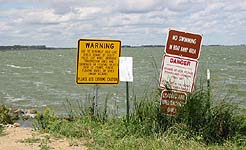The head of the Corps of Engineers has decided to delay a key milestone in a plan to deal with the high water level at North Dakota's Devils Lake. In announcing the delay on Aug. 12, the Chief of Engineers, Lt. Gen. Robert Flowers, said environmental issues hadn't been adequately addressed in a Corps draft planning report and environmental impact statement that was issued in February.
Flowers' action is expected to put off a final EIS decision until spring of 2003. The move didn't sit well with the state's congressional delegation. Sen. Byron Dorgan (D-N.D.) blasted Flowers' announcement as "one more broken promise from the Corps and we're tired of it." Dorgan adds, "Meanwhile people in the Devils Lake basin continue to [have] chronic lake flooding that comes and stays."
Covering about 100,000 acres, Devils Lake, in northeastern North Dakota, is the state's largest natural lake. It is saline and has no stream or river outlets. The lake's level has risen 25 feet in eight years, causing destruction or relocation of more than 500 homes, and leading to construction of levees and raising roads, all at a federal cost that exceeds $350 million.
 |
| (Photo credit: North Dakota State Water Commision) |
The Corps estimates that if the lake keeps rising, it would result in an additional $500 million in damages in the vicinity. If it rises 12 feet, the Corps says that also would threaten the Sheyenne River and Red River of the north, which flows into Canada. Such overflows, the Corps says, would pose water quality problems because the lake has high concentrations of chlorides and sulfates.
The draft EIS and planning document covered a variety of options for addressing the lake's high level. Most of the attention has focused on a 28-mile-long emergency outlet from the lake to the Sheyenne River. The project, estimated to cost $98 million, would include pumping facilities, an open channel and an underground pipeline. It would have a pump capacity of 300 cfs. A 1997 federal statute directed the Corps to do preliminary design on that outlet plan.
But the Corps' draft report notes that even if the outlet is approved and built, many other "infrastructure protection measures," including dams, also would be needed to safeguard the city of Devils Lake, as well as key roads and facilities. A Corps spokesman says those infrastructure measures could cost $139 million to $585 million.
Flowers said, "The draft report recommends infrastructure protection, but this also leaves some unmitigated risks. In my professional engineering opinion additional analysis is necessary to address all of the environmental issues that have been raised."
The Corps spokesman says the environmental issues to be addressed include water quality, particularly the salinity level, and questions raised by Canada, Minnesota and others about invasive species.
Rep. Earl Pomeroy (D-N.D.), the state's lone U.S. House member, said that two weeks earlier the Corps had assured the congressional delegation that a final environmental statement supporting a water outlet from the lake would be issued the week of Aug. 12. He criticized officials from Canada, Minnesota and the U.S. Environmental Protection Agency for opposing the outlet plan.

Post a comment to this article
Report Abusive Comment